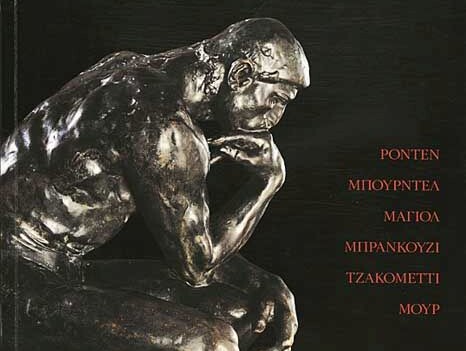
From 09.06.2004 to 30.09.2004
Sculpture has played a pivotal role in the history of the Olympic Games. The very form of ancient Greek art was determined by its relation with the athletic ideal. Greek art abounds with fit and graceful nude bodies of youthful champions in the national games.
The return of the Olympic Games to their ancient cradle necessitated a tribute to sculpture, the celebration of the human form at the moment of the supreme physical and spiritual glory.
These six leading sculptors were selected because they remained true to the anthropocentric tradition established by Greek art, but also for their contribution to the radical renewal of this tradition. Indeed, each of these six leading modern sculptors reveals through his art a different path on the course from the traditional yet radically renewed, vibrant art of the three former ones — Rodin, Bourdelle, Maillol — to the three versions of modern sculpture represented by the artists of the latter group — Brancusi, Giacometti, and Moore.
These six leading sculptors have all marked a new approach to and reappraisal of the teaching of ancient art: A great admirer of ancient art, Rodin was also an avid collector. Some of the unique pieces of his collection went on display in Athens alongside his works. Bourdelle’s predilection was for Olympia and archaic sculpture, which helped him reinstate the monumental character of sculpture. Maillol sought the archetypal, abstracted and lush Mediterranean goddess of fertility incarnated by Praxiteles’ Aphrodite.
Brancusi returned to the teaching of Cycladic sculpture. His pure, condensed figures usher in modern sculpture. Giacometti was inspired for his wiry figures by the graceful figures of geometric sculpture and Etruscan figurines. Yet, he charged them with a dramatic sentiment that voiced the 20th-century man’s existential angst. Henry Moore, finally, restored the inherent “classical” fullness and optimism to the human figure, inventing the sculptural principle of the vital form. His reclined figures, warriors and maternity goddesses were often inspired by Antiquity.
The sculptors selected for
this exhibition were often related to each other by teacher, pupil and follower relationships, a fact that lends additional cohesion to this group.
The exhibition was organised by the National Gallery in cooperation with the six museums and entities in possession of the largest collections of these artists’ works: the Rodin, Bourdelle, Maillol museums, the Centre Pompidou, the Giacometti Association and the Henry Moore Foundation.
The directors of these museums and collections cooperated in artwork selection.
The exhibition was curated and supervised by Marina Lambraki-Plaka, Director, National Gallery,
Jacques Villain, Director, Rodin Museum,
Antoinette Romain, Director of Collections, Rodin Museum,
Bertrand Lorquin, Maillol Museum,
Juliette Laffon, Director, Bourdelle Museum,
Veronique Gautherin, Curator, Bourdelle Museum,
Doina Lemny, Curator, Centre Pompidou,
Mary-Lisa Palmer, Director, Giacometti Αssociation,
Roxana Theodorescu, Director, National Art Museum, Bucharest
David Mitchinson, Director of Collections, Henry Moore Foundation at
Perry Green, UK,
Annita Feldman-Bennet, Curator,
Henry Moore Foundation,
Museum coordinator for the National Gallery: Tonia Giannoudaki, Curator
Sponsor: Cultural Olympiad
Communication sponsor: ERT

